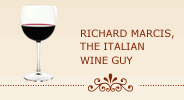What I’m Drinking Now - the Pleasurable Wines of Puglia
Puglia (also known as Apulia) has always produced prodigious quantities of wine. Italy is the largest wine-producing country in the world and Puglia generally contributes from 18 to 20 percent of the country’s total, more than any other region. Historically, much of Puglia’s wine production has consisted of rough and rustic red wines that were either consummed locally or shipped north for the supermarket export trade.
However, much has changed in recent years. The overall quality of wines from Puglia has improved considerably in the last several decades due to enhanced regulations and, more importantly, more inspired winemaking by a number of Puglian producers that emphasizes quality over quantity.
The international recognition garnered by some dynamic Puglian winemakers in conjunction with the realization that Puglia’s climate and habitat offer great potential for growing quality grapes has led to a wine rush in Puglia. Wineries from northern Italy and elsewhere have made substantial investments in Puglia in the form of land and vineyard acquisitions, capital improvements and infusions of modern winemaking technologies. Marchesi Antinori and Gianni Zonin are two marquee-name producers that have made substantial investments in wine operations in Puglia recently to great commercial successe.
Did I mention 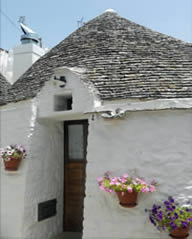 the scenery? The region’s beautiful sandy beaches, bucolic countryside carpeted with olive trees and vineyards, historic towns that reflect the region’s Greek, Roman, Turkish and Spanish ancestry and the unique, ancient round houses, called trulli, with conical roofs made entirely of stone are all making this long-neglected region an increasingly popular international tourist destination.
the scenery? The region’s beautiful sandy beaches, bucolic countryside carpeted with olive trees and vineyards, historic towns that reflect the region’s Greek, Roman, Turkish and Spanish ancestry and the unique, ancient round houses, called trulli, with conical roofs made entirely of stone are all making this long-neglected region an increasingly popular international tourist destination.
And then there are the wines. Puglia has 29 DOC wine zones of which more than half (16) are located in the southern-most part of Puglia in what is called the Salento peninsula, the fertile, flat and sun-drenched tip of the “heel” of the “boot” that comprises geographic Italy. Puglia also has 4 DOCG wine zones of which 3 are in the Castel del Monte wine region, an up-and-coming wine area that holds great promise. The zone takes its name from the octagonally-shaped 13th century castle lying south of the city of Andria that is a landmark of medieval military architecture (see photo at right).
The three main red grape varieties in Puglia are all warm-weather, indigenous varieties - Negroamaro, Nero di Troia and Primitivo. Negroamaro (literally “black bitter’) is the region’s most widely planted variety. It is found primarily in the Salento zone and is used extensively in the production of Puglia’s full-bodied and robust Salice Salentino wine. However, because of extensive experimentation with production and ageing regimens, there is a vast range in styles of Negroamaro. While Negroamaro generally makes robust wines, they can vary considerably in terms of color, acidity and alcohol. Negroamaro is also frequently blended other traditional or international varieties such as Montepulciano, Malvasia Nero and Cabernet Sauvignon.
Primitivo is another widely-planted variety found primarily in the Salento zone and west-central Puglia. Genetically related to Zinfandel found in California, Primitivo is the basis for what is arguably Puglia’s best category of red wine, the exuberant and intense Primitivo di Manduria from the Salento zone. Primitivo is used exclusively in the production of Primitivo di Manduria Dolce Naturale, the deliciously sweet DOCG dessert wine from the Salento area.
Primitivo wines are also produced in the Gioia del Colle zone further north in west-central Puglia. While these wines exhibit Primitivo’s benchmark ripe, robust flavors, they tend to be a touch more subtle and nuanced than Primitivos from the Salento zone.
Nero di Troia (also known as Uva di Troia) is grown primarily in central and northern areas of Puglia. This variety can produce elegant wines with floral aromas and firm structure. However, this grape is also high in tannins. To avoid the time and expense associated with the ageing required to soften the tannins, many producers historically opted make the wine more approachable by blending the Nero di Troia with other low-tanning varieties. However, various technological advances combined with some enterprising winemaking procedures have been found that are able to tame Nero di Troia’s fierce tannins. The result is that wines made exclusively of Nero di Troia and that do not require extensive ageing have become more common in recent years. Uva di Troia is gaining increased recognition as a premium wine grape and is the primary variety in the Castel Del Monte zone in central Puglia. Some interesting, age-worthy Aglianico wines are also produced in the Castel del Monte area.
While it is the red wines from Puglia that receive the most attention, Puglia also produces some appealing dry, crisp white wines. Whites made from local varieties such as Verdeca, Bombino Bianco and Greco Bianco are the most common although some white wines made from Chardonnay are gaining in popularity. Another popular white varietal is Moscato which is used primarily in the production of sweet, dessert-style wines. Moscato grapes grown in the area around the coastal city of Trani are used primarily for the production of the ambrosial, sweet Moscato di Trani wine. The downside is that production of quality white wines remains limited and not many are exported to the U.S.
I have become enamored of the wines from this part of southern Italy and in recent weeks have had the opportunity to taste several wines from different regions in Puglia. Part of this is the result of attending a wine-themed Puglia dinner at the Al Dente Ristorante in Washington, D.C. where I had the pleasure of tasting a white, two reds and a sweet dessert wine from Puglia. I also tasted several wines from Puglia at the I Trulli Ristorante/Enoteca in New York when I visited there recently. This charming restaurant and wine bar features the foods and wines of Puglia.
Since Puglia wines are generally very food-friendly, I also have had occasion to enjoy several different red Puglia wines at home with dinner and friends in recent weeks.
Listed below are some of the pleasurable wines from Puglia that I’ve had the opportunity to taste recently. This list is not meant to be representative of the vast array of wines produced in Puglia. Nor are they necessarily Puglia's "best" wines. Rather they are simply wines that I have enjoyed in recent weeks and that indicate the variety of Puglian wines generally available in the U.S.
The wines are listed alphabetically by producer.
Botromagno, Nero di Troia 2008 (about $17)
The Botromagno winery is relatively new by Puglian standards, dating back only to 1991, when the D’Agostino family acquired the local cooperative winery. But the winery has within a relatively short period of time become one of Puglia’s premier winemaking facilities. Its natural winemaking processes and eco-friendly, state-of-the-art winemaking cellar have resulted in several environmental certifications and awards for the winery.
Nero di Troia is the estate’s primary red variety. It is an an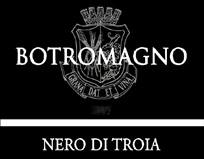 cient grape variety that thrives in central and northern Puglia but is little found elsewhere. The estate’s 2008 Nero di Troia is made entirely with Nero di Troia aged in stainless steel tanks for 20 months. Afterwards, the wine spends an additional 6 months ageing in the bottle prior to release for sale.
cient grape variety that thrives in central and northern Puglia but is little found elsewhere. The estate’s 2008 Nero di Troia is made entirely with Nero di Troia aged in stainless steel tanks for 20 months. Afterwards, the wine spends an additional 6 months ageing in the bottle prior to release for sale.
Botromagno’s ’08 Nero di Troia is an impressive wine. It has a deep ruby color and alluring fruity aromas with a hint of violets. Its plum and dark fruit flavors with kitchen spice notes have a pleasing rustic accent. The wine’s plush, velvety texture is balanced with good acidity. It’s a fully mature, food-friendly wine that’s ready to drink now.
Cantele, Salice Salentino Riserva 2009 (about $12)
Founded in the early 1980’s, the Cantele winery today is run by the third generation of the Cantele family. The winery is located in the town of Guagnono in the heart of Negroamaro territory in the Salento zone. Cantele is a big operation, producing over 2 million bottles of wine a year made with both classic indigenous and “international” varieties.
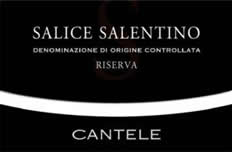 The Salice Salentino Riserva wine is made entirely of Negroamaro. After fermentation is complete, the wine spends a year ageing in a combination of both new and used oak barriques and barrels followed by two years in the bottle. Its dark color and dark fruit and spice aromas indicate this is going to be a ripe, rich and delicious wine - and it doesn’t disappoint. The tannins make their presence known but are not overbearing and work in tandem with the wine’s fresh acidity to keep everything in balance.
The Salice Salentino Riserva wine is made entirely of Negroamaro. After fermentation is complete, the wine spends a year ageing in a combination of both new and used oak barriques and barrels followed by two years in the bottle. Its dark color and dark fruit and spice aromas indicate this is going to be a ripe, rich and delicious wine - and it doesn’t disappoint. The tannins make their presence known but are not overbearing and work in tandem with the wine’s fresh acidity to keep everything in balance.
Not that I have to resort to a higher authority when reviewing wines, but it’s worth noting that Cantele’s 2009 Salice Salentino Riserva is the recipient of Gambero Rosso’s prestigious Tre Bicchiere award and also their pick for the Best Value Wine of the year. That is quite an honor for any winery, big or small.
Duca Carlo Guarini, “Rarum” Passito Rosso 2007 (about $30 for 500 ml)
This delicious sweet red wine comes with a pedigree. The Duca Carlo Guarini estate in southern Puglia dates back to the 10th century and the Guarini family can trace their ancestry back to a knight in the First Crusade. The estate itself is dotted with historic buildings and ancient fortifications dating back centuries.
This sweet dessert wine is made by the passito process whereby the 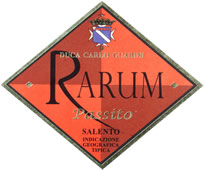 grapes are left to shrivel and sweeten prior to crush. It is a blend of indigenous Negroamaro and Malvasia Nera grapes. It has an inky black color with a purple edge and powerful but elegant prune and plum aromas. Its dark fruit flavors are rich, deep and ample and the smooth tannins are streaked with a fig and honey sweetness.
grapes are left to shrivel and sweeten prior to crush. It is a blend of indigenous Negroamaro and Malvasia Nera grapes. It has an inky black color with a purple edge and powerful but elegant prune and plum aromas. Its dark fruit flavors are rich, deep and ample and the smooth tannins are streaked with a fig and honey sweetness.
This dolcissimo wine is at its best when served with rich desserts like caramels, chocolate, dried fruits, walnut or pecan tarts or gianduia (an Italian dessert paste made with hazelnuts and dark chocolate). Better yet, open a bottle, lean back in your Barcalounger and enjoy the wine by itself as a vino da meditazione (a “meditation” wine).
Duca Carlo Guarini, “Tenuta Piutri” Negroamaro IGT Rosso 2009 (about $16)
A portio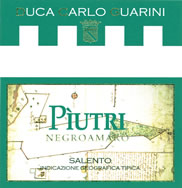 n of the Tenuta Piutri Negroamaro is aged for 8 months in barriques and the remainder in steel. Its inky black color portends a ripe, bold wine. While it has a fairly subdued bouquet its dark fruit flavors come through impressively and lavish your mouth with rich berry fruit. It has Negroamaro’s benchmark smooth acidity backed up by soft tannins with just a touch of sweetness on the finish. When I last tasted this wine it accompanied a main course dish of veal stuffed with eggplant and tomato sauce, a truly cosmic match.
n of the Tenuta Piutri Negroamaro is aged for 8 months in barriques and the remainder in steel. Its inky black color portends a ripe, bold wine. While it has a fairly subdued bouquet its dark fruit flavors come through impressively and lavish your mouth with rich berry fruit. It has Negroamaro’s benchmark smooth acidity backed up by soft tannins with just a touch of sweetness on the finish. When I last tasted this wine it accompanied a main course dish of veal stuffed with eggplant and tomato sauce, a truly cosmic match.
Duca Carlo Guarini, “Vigne Vecchie” Primitivo 2009 (about $17)
The wine is made entirely from Primitivo grapes grown in the Duca Carlo Guarini’s Vigne Vecchie (which means “old vines”) vineyard. It has a deep purple color that borders on black and ripe fruit and blackberry aromas with just a hint of aromatic herbs evoca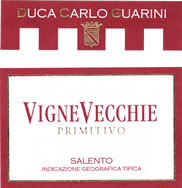 tive of its Mediterranean patrimony.
tive of its Mediterranean patrimony.
There is nothing shy or reserved about this wine. It has a firmly structured presentation that coats your mouth with deeply concentrated blackberry and dark currant flavors tinged with spicy fruit nuances that follow through in the finish. It has a good tannic structure that complements its impressive density.
Leone de Castris, “Eloveni” Salento IGT Negroamaro 2010 (about $17)
This wine is made entirely of Negroamaro grapes harvested from 30 year old vines. After fermentation the wine is aged in stainless steel tanks for 6 months and then spends 3 months resting in the bottle prior to release for sale.
It has a dark red color and prolific cherry and red fruit aromas. The wine is medium to full-bodied and is more polished and elegant and less tannic than many other sun-splashed, earthy Negroamaro wines. It is smoothly textured with delectable dark fruit flavors, bright acidity and discrete tannins. This wine pairs well with appetizers or main courses like pasta, salmon, and risotto and chicken dishes such as the classic Coq au Vin or Indian Chicken Tikka Masala.
Masseria LiVeli, Verdeca Valle d’Itria IGT 2011 (about $18)
This estate is owned by the Falvo family, a prosperous family that knows a few things about wine. For decades they ran the very successful Avignonesi winery in Tuscany known for its award-winning Vino Nobile de Montepulciano and Vin Santo wines. They sold their interest in Avignonesi a few years ago and purchased the ancient Masseria LiVeli estate in Cellino San Marco, about half-way between Brindisi and Lecce in the Salento Peninsula, which they subsequently upgraded and expanded. They have focused their efforts on producing wines from indigenous Salento varieties like Negroamaro, Primitivo and Verdeca.
The Verdeca Valle d’Itria IGT is made from indigenous Verdeca grapes with the addition of a small amount (10 percent) of Fiano Minutolo, another indigenous white variety.
The wine has a delightful nose of flowers and white peaches. “It smells like daisies” one colleague noted. There is a burst of citrus and tropical fruit flavors in the initial sips. It is lean with a rich fruity taste balanced with tart acidity. The wine is a great accompaniment to appetizers, especially if they include shellfish.
Rivera, “Cappellaccio” Castel del Monte Aglianico Riserva 2006 (about $21)
Rivera is arguably the finest producer in the Castel del Monte DOC as 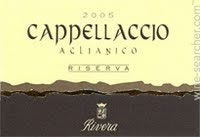 well as one of the best in Puglia overall. His Cappellaccio is made entirely of Aglianico from Rivera’s vineyards in the Castel del Monte DOC zone. The wine spends 12 months ageing in oak barrels of varying ages and another 12 months in the bottle before release for sale. This medium to full-bodied wine has spicy, herbal aromas, ripe plum and berry flavors and firm tannins. It is a wine that will age gracefully for at least another five years.
well as one of the best in Puglia overall. His Cappellaccio is made entirely of Aglianico from Rivera’s vineyards in the Castel del Monte DOC zone. The wine spends 12 months ageing in oak barrels of varying ages and another 12 months in the bottle before release for sale. This medium to full-bodied wine has spicy, herbal aromas, ripe plum and berry flavors and firm tannins. It is a wine that will age gracefully for at least another five years.
Tormaresca, “Bocca di Lupo” Castel del Monte Aglianico 2006 (about $34)
The Antinori family, one of the most famous names in 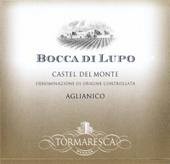 the Italian wine constellation, founded the Tormaresca winery in 1998. The Bocca di Lupo (which translates as “mouth of the wolf”) consists entirely of Aglianico grapes grown on the Antinori estate’s vineyards in Castel del Monte. The wine spends 15 months ageing in small oak barriques and 12 months in the bottle prior to release. The Bocca di Lupo exhibits the best qualities of the Aglianico variety with rich, aromatic flavors, firm structure and a long, pleasantly acidic finish.
the Italian wine constellation, founded the Tormaresca winery in 1998. The Bocca di Lupo (which translates as “mouth of the wolf”) consists entirely of Aglianico grapes grown on the Antinori estate’s vineyards in Castel del Monte. The wine spends 15 months ageing in small oak barriques and 12 months in the bottle prior to release. The Bocca di Lupo exhibits the best qualities of the Aglianico variety with rich, aromatic flavors, firm structure and a long, pleasantly acidic finish.
©Richard Marcis
April 25, 2013
Return to Wine Reviews and Musings
For reveiws of other Italian wines, see italian wine reviews
Help keep this website ad-free and independent.
Consider making a contribution to support the work of WineWordsWisdom.com.

